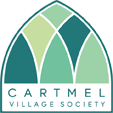Welcoming Visitors
Introduction to Cartmel
 There’s a timeless charm to Cartmel – stemming from its heyday of welcoming monastic visitors to the traditional market place and Priory Church, both of which remain key attractions today. Cobbled narrow streets with characterful 18th century houses, picturesque inns, and independent shops are pleasantly a long way from a typical high street, which only adds to its appeal.
There’s a timeless charm to Cartmel – stemming from its heyday of welcoming monastic visitors to the traditional market place and Priory Church, both of which remain key attractions today. Cobbled narrow streets with characterful 18th century houses, picturesque inns, and independent shops are pleasantly a long way from a typical high street, which only adds to its appeal.
The development of Cartmel village was helped by the establishment of the Priory Church, a Grade I listed building, in 1189. Along with the church, the Gatehouse in the village square, which was built around 1330, is all that remains of the Augustinian Cartmel Priory.
With excellent transport links, just 20 minutes from junction 36 of the M6 motorway, and 30 minutes by a picturesque rail journey from the West Coast mainline at Lancaster, Cartmel is a small village on the edge of the Lake District National Park in Cumbria. Steeped in history and importance, Cartmel served as a gateway for the west of Cumbria for many centuries when visitors and traders coming from the south had to cross the Morecambe Bay sands by carriage or cart to reach the village. Today, Cartmel is a well-established tourism destination and food hotspot with two Michelin-starred restaurants (L’Enclume – 2 stars & Rogan & Co – 1 star) and is home to the world renowned Cartmel Sticky Toffee Pudding.
Visitors also flock to Cartmel for the Racecourse, which although fairly small, has the third highest average attendance of any jumps track in the UK behind Aintree and Cheltenham. The unique track allows people to enjoy national hunt racing in its most original format and there are nine annual race days running from May through to August Bank Holiday weekend.
There is no shortage of good quality accommodation for visitors, ranging from hotels and pubs to B&B’s, self-catering cottages, and holiday parks in and around Cartmel village.
The village has won many awards in both the Britain in Bloom and Cumbria in Bloom competitions.
Here are just some of our suggestions of what to look out for within Cartmel village:

Cartmel Priory
It goes without saying that the jewel in Cartmel’s crown is the Priory. Standing at the heart of the village for more than 800 years, the medieval Priory was founded by William Marshal, 1st Earl of Pembroke, who was also described as the architect of the Magna Carta. The Great East Window dates back to 1420 and is thought to be the priory’s greatest architectural glory, influenced, and perhaps even designed, by the same people who built the Great East Window of York Minster. Look out for the 15th century misericords of mermaids, unicorns, elephants, and apes in the choir stalls. Outside, the unique square belfry tower is the only one of its kind in the UK.

Medieval gatehouse
The Grade II listed Medieval Gate House, which stands in Cavendish Street was once the main entrance to the Priory compound. Now owned by the National Trust, it is described by English Heritage as an ‘excellent example of a medieval monastic gatehouse’ and was also the site of a medieval court and the very first village school.

Fish slabs
Cartmel still has the old granite fish slabs in the main village square where, hundreds of years ago, the daily catch would be laid out. Today, a mobile fish van still parks there once a week on a Thursday morning. Cartmel Village Society will be contributing toward the refurbishment of the fish slabs in 2021.

Stone slabs
There are two stone slabs in the village, which were used for hundreds of years by village women to wash their clothes. One is across the beck at the entrance to the car park and the other is in Priest Lane

Priest Lane
The corner of Priest Lane and Barn Garth has great historical significance in the village as the houses that formed the eastern boundary of the Priory Grounds. (Hazeldene & Yew Tree Cottage) housed the secular priests who ministered to the village – hence the street name. The Tithe Barn bungalow is also on the foundations of the original Tithe Barn.

Raleigh Bike advert
There’s a quirky vintage 1920’s enamelled metal Raleigh Bike advert opposite the entrance to L’Enclume on Cavendish Street.

The Cavendish family
The Cavendish family, who for over a hundred years, have lived at nearby Holker Hall, built both Cartmel Primary School and the Vicarage plus houses for the headmaster and headmistress. The private walled garden across from the Vicarage is home to the Priory’s orchard. Cartmel Racecourse is also owned by the family.

Friends Meeting House
The Friends Meeting House on Haggs Lane in Cartmel was built to a design by architect, Alfred Waterhouse, who was from a Quaker family. The Friends Meeting House was one of his early works prior to his later designs for London’s Natural History Museum and Manchester Town Hall. Now a Grade II listed building, the Friends Meeting House has been described as ‘a precious pocket of calm in an otherwise hectic world.’
